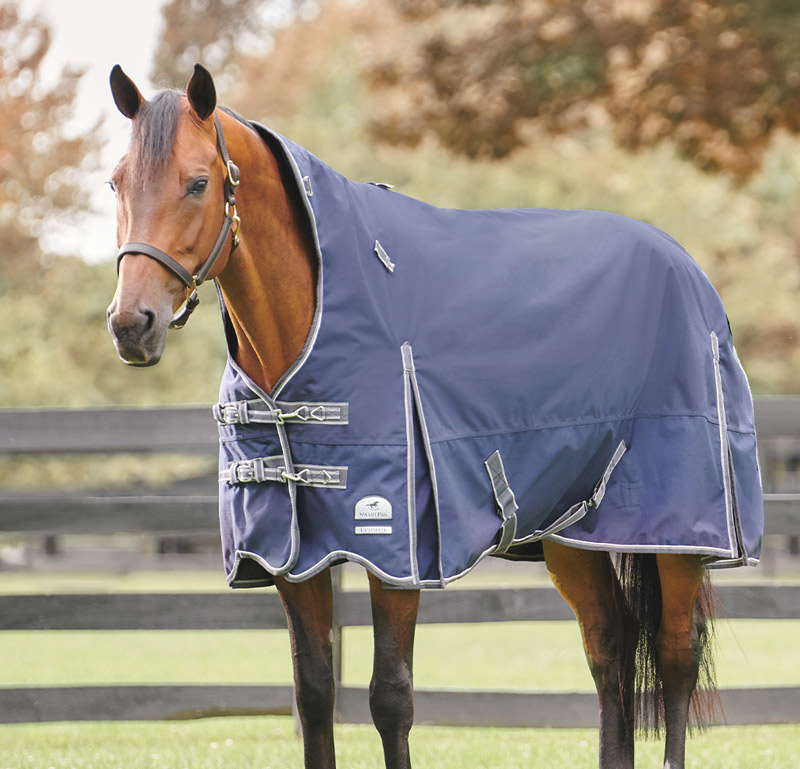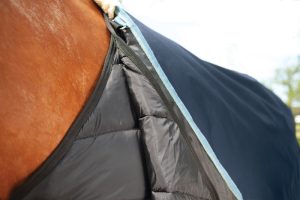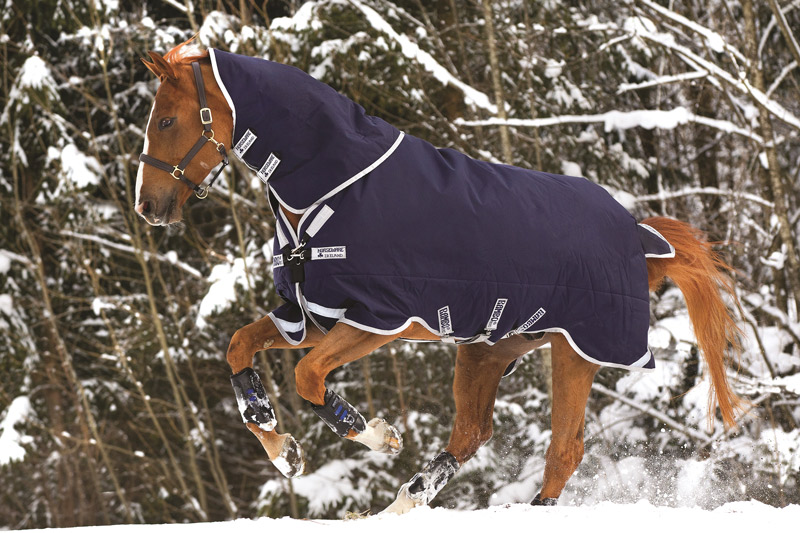
During the coldest days of winter, you layer on thermals, fleece, insulated coveralls, and maybe even a headlamp to go out to the barn. There, your horse is sporting layers of his own, including a winter coat and possibly also a wardrobe of blankets. When the weather is miserable, it can be tempting to rush through barn chores. However, to ensure that your horse has good hair days as well as good health this winter, here’s what the experts recommend when it comes to grooming and blanketing.
Why Do Grooming in Winter?
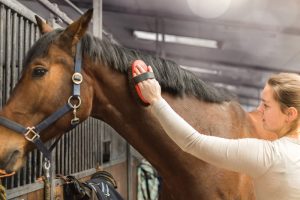
“Grooming is the best connection to your horse,” says former Olympic groom Liv Gude, founder of ProEquineGrooms.com. She sees grooming as a fantastic opportunity to check on your horse’s health, including his skin condition, vital signs, and leg and hoof health, in addition to spending quality time together and being able to provide mental enrichment.
Gude recommends checking vital signs daily, including digital pulses. (A strong digital pulse on the inside of the ankle may indicate a stone bruise, brewing abscess or laminitis.) Other daily winter “must-dos” include grooming the entire horse with grooming gloves and a brush, plus a thorough, hands-on inspection. She looks for swellings, scrapes, soreness, and anything abnormal.
Lisa Nesson, DVM, of Irongate Equine Clinic in Madison, Wisc., agrees that winter grooming is an important way to monitor your horse’s skin and coat condition, and can give clues to the health of the horse.
“Grooming allows you to go over your horse from head to toe looking for any issues,” she says, adding that owners should pay special attention to the legs and undersides. “It also helps you keep track of his body condition score, assessing if he’s losing or gaining concerning amounts of weight during the cold winter months.”
General body condition and weight are important to monitor all times of year, she says, but particularly when horses are dealing with colder weather.
Blanket Decisions
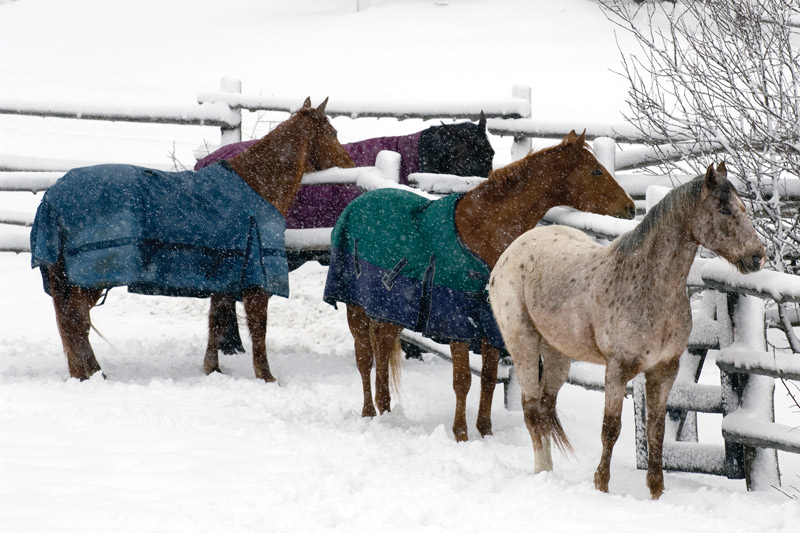
As the days become shorter, your horse begins growing his winter hair. This winter coat is well-designed by nature to keep your horse warm—with a few exceptions.
“The winter hair coat is typically a thicker coat, which helps keep the horse warm by providing a greater amount of insulation,” explains Nesson. “This occurs due to the longer hairs as well as the increased ability for the horse to hold the hair on end, which creates a pocket of warm air against the skin. Anything that prevents the hair from standing on end can limit the horse’s ability to self-regulate his temperature and stay warm. This includes things such as rain, blankets and heavy snow.”
It’s important to consider your horse’s individual needs when it comes to blanketing. Nesson reminds that a horse in good body weight with an adequate winter coat who is otherwise healthy and is provided adequate forage and shelter can do just fine without a blanket, but there are various instances where blanketing might be recommended.
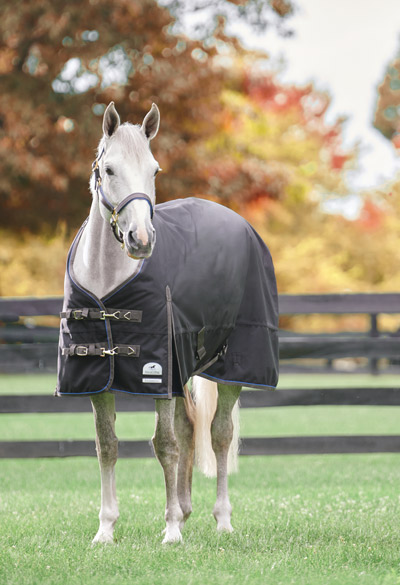
“If the horse is underweight or struggling to maintain a healthy weight, I would recommend blanketing him when the temperatures are below freezing,” she says. “Blanketing can also assist with insulation. If there is inclement weather, or sudden changes in weather that the horse may not yet be physiologically prepared for, he should be blanketed.”
Gude makes blanket decisions on a case-by-case basis for each horse.
“For a fat, retired horse living near the North Pole that resembles a woolly mammoth, I won’t use a blanket,” she says. “For the same horse that’s a hard keeper and loses weight in the winter, I would.”
Blanket Right
Blanketing your horse shouldn’t be complicated, but it does require a level of care and attention. According to Nesson, a common mistake many owners make is using blankets that are an inappropriate weight for the weather or the horse.
“Lighter-weight blankets may be necessary in fall and spring months, while you may need to rotate in a heavier blanket during winter months and cold spells,” she says.
Nesson also emphasizes the importance of removing the blanket throughout the winter to get eyes on your horse and assess his condition.
“I see horses that have either gotten too thin or too overweight under their blankets during the winter, and it’s not noted nor addressed until spring when the blanket is removed,” she says. “We also see frequent rubs, sores and entanglements when horses wear poorly fitted blankets—getting the correct size and checking fit is very important.”
You’ll also want to look for clues that your horse is comfortable in his blanket—not too warm, not too cold, but just right. And look for rub, which can show poor fit.
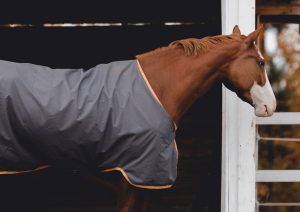
“The signs of inappropriate blanket weight are typically shivering or sweating,” says Nesson. “Blankets are rated for the temperature that they should protect above, so select a blanket for the weather you are anticipating, and remember, it may change.”
Keep Clean and Curry On
When it comes to grooming, your horse’s winter coat can be a little high maintenance.
If a horse in the northern U.S. is ridden to the point of sweat, Gude clips areas where they sweat the most and uses blankets. For a horse in the southern U.S. that grows a long coat and sweats by just existing, even in the shade, she clips and uses lighter sheets as needed.
“Plan on more time curry combing,” says Gude. “Use a vacuum if you have one. Do some more curry combing. Use spot removers as needed. Pick up the curry comb and go to town again. Perhaps use a stiffer and longer brush to lift off all of the dust from your horse. Curry yet again.”
To maintain a good grooming, sheets and blankets are an essential part of Gude’s winter grooming strategy. In addition to convenience for the rider, she believes it contributes to a cleaner, and possibly healthier, horse.
“A sheet or blanket helps keep dirt and dust from your horse’s winter coat,” she says. “There’s not as much dirt and dust trapped in a long winter coat, which saves grooming time and can help ward off skin problems. The sheet also acts like a physical barrier to stains and can allow you to ride if your horse has been standing out in the rain, as they do.”
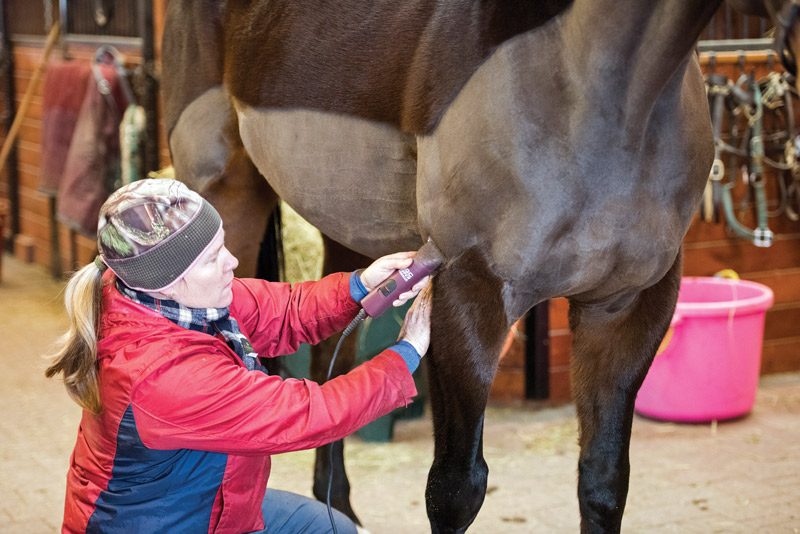
To Clip or Not to Clip?
If your horse’s coat is causing him to overheat or become a sweaty mess, requiring hours to cool out, you should consider body clipping. Clipping to address the sweaty areas does a couple of things for your horse.
“He will be better able to thermoregulate, as the sweat can do its job of evaporating and cooling his body without so much hair,” says Gude. “A horse that’s wet from sweat is hot under his thick coat. When you stop his exercise, he’s a wet horse in the cold air, which can take his temp too low. If the sweat is evaporating in the clipped areas, he won’t need lots of hand-walking, coolers, towel drying, and time to dry off after exercise. No sweat also means that his hair won’t be holding onto moisture, which can often pave the way for bacterial infections of the skin.”
For a horse in the southern U.S. that grows a long coat and sweats by just existing, even in the shade, she clips and uses lighter sheets as needed. Although clipping can seem like a big hairy deal, Gude has some reassuring advice.
“If clipping your horse helps him be healthier and more comfortable, you should clip him,” says Gude. “Clipping isn’t an all-or-nothing deal; it’s customizable to each and every horse and climate. You can use any pattern that you like. Maybe it’s a pattern you concoct. It doesn’t have to match a pattern you saw on the internet. You can also use clipper combs and guides to take a little off the top instead of clipping all the way to the skin.”
Body clipping isn’t just for show horses; it can also be beneficial for your horse’s comfort.
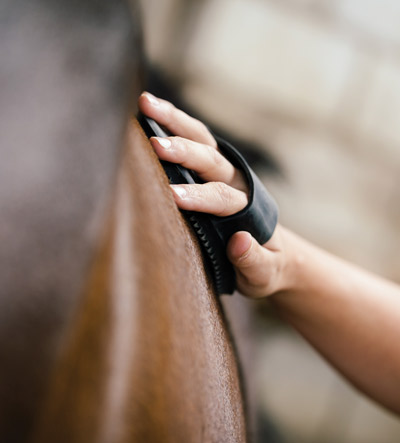
“Don’t skip on clipping if your horse is sweating beyond a comfortable state, either because of exercise or the climate,” Gude advises.
If you clip, remember that you’ll need to be committed and attentive to appropriate blanketing for the weather conditions. (See “Dress Your Horse for the Weather” below.)
Ultimately, Gude’s main rule of blanketing is that your horse should get a blanket if he needs a blanket.
“Take it back to the health and comfort of your individual horse,” says Gude. “There aren’t any hard and fast rules. If you do decide to use sheets and blankets, you must take them off daily for grooming, and they are not a replacement for good care.”
About the ExpertsLiv Gude is a former professional groom for Olympians, including Guenter Seidel. She started proequinegrooms.com to share her knowledge about grooming, barn management, early detection of illness, lamenesses and overall health with horse owners. Gude also hosts the Pro Equine Grooms podcast about horse care and grooming. Lisa Nesson, DVM, is part of the team at Irongate Equine Clinic in Madison, Wisc. Nesson is a past president of the Wisconsin Equine Practitioners Association. She enjoys sharing her knowledge and passion for equine health care with many organizations throughout the Midwest. She and her family raise and train American Saddlebreds. |
This article about winter grooming and blanketing appeared in the November/December 2020 issue of Horse Illustrated magazine. Click here to subscribe!

